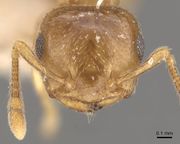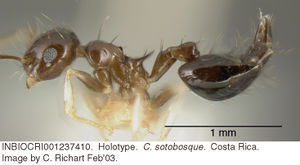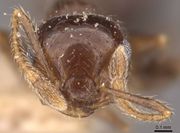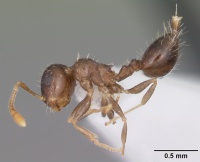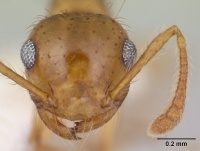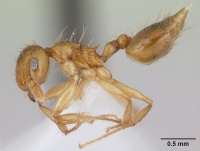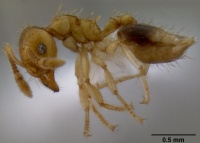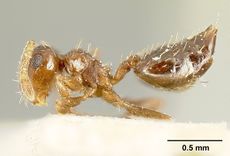Key to Crematogaster of Costa Rica
This worker key is based on: Longino, J.T. 2003a. The Crematogaster of Costa Rica. Zootaxa 151: 1-150.
You may also be interested in
1
- Face appearing somewhat bare, with dilute appressed pubescence, and usually six or fewer erect setae (Fig. 4); if more (up to 20), workers strongly polymorphic and propodeal spiracle very large (Fig. 7A, stollii); antennal scapes, when laid back, fail to reach posterior margin or only slightly surpass posterior margin; petiole in dorsal view only slightly longer than wide to distinctly wider than long (PTWI > 83), sides convex or straight and parallel, never long and gradually converging anteriorly . . . . . 2
- Face with abundant erect to suberect pilosity; in some cases setae may be somewhat thickened, relatively short, and curved, but still with a relatively uniform vestiture of standing pilosity (Fig. 4); no underlying short appressed pubescence; scape length variable; petiole in dorsal view variable, subquadrate to elongate, with sides straight and subparallel to converging anteriorly, never with strongly convex sides . . . . . 9
2
return to couplet #1
- Postpetiole distinctly bilobed, much broader than long in dorsal view (PPI > 150), with broad median longitudinal sulcus; head somewhat elongate (CI 100-103); scapes when laid back just reach or slightly surpass posterior margin of head; face completely devoid of erect setae . . . . . Crematogaster distans
- Postpetiole subcircular or subquadrate, not broadly bilobed (PPI < 150), median sulcus absent or weakly impressed; head of larger workers distinctly wider than long (CI > 107); scapes variable; face usually with at least one pair of erect setae . . . . . 3
3
return to couplet #2
- Propodeal spiracle very large (Fig. 7A); face with up to 20 erect setae . . . . . Crematogaster stollii
- Propodeal spiracle smaller (Fig. 7B); face usually with 6 or fewer erect setae . . . . . 4
4
return to couplet #3
- Pilosity on fourth abdominal tergite composed of abundant filiform flexuous setae, a combination of long erect setae and abundant, long, suberect pubescence . . . . . Crematogaster crucis
- Pilosity on fourth abdominal tergite a combination of completely appressed pubescence, and, when present, a variable number of erect setae; erect setae short, weakly to strongly flattened and stiff . . . . . 5
5
return to couplet #4
- Promesonotum with at least humeral setae long and filiform; dorsal face of propodeum short, not distinctly differentiated from posterior face . . . . . 6
- Promesonotum with dorsal setae short and stiff; dorsal face of propodeum differentiated or not . . . . . 7
6
return to couplet #5
- Promesonotum with 7-10 medium length flexuous setae . . . . . Crematogaster moelleri
- Only humeral setae long and filiform, other dorsal setae shorter and stiff . . . . . Crematogaster erecta
7
return to couplet #5
- All except the largest workers (HW > 1mm) without differentiated dorsal and posterior faces of propodeum (Fig. 7C); fourth abdominal tergite completely lacking erect setae; anteroventral petiolar tooth well developed, acute and projecting . . . . . Crematogaster rochai
- All workers, even small ones, usually with short, differentiated dorsal face of propodeum (Fig. 7D); fourth abdominal tergite always with at least a few erect setae; anteroventral petiolar tooth variable . . . . . 8
8
return to couplet #7
- Anteroventral petiolar tooth relatively well-developed and sharp (Fig. 7E); fourth abdominal tergite with abundant setae that are uniformly distributed . . . . . Crematogaster crinosa
- Anteroventral petiolar tooth relatively less well-developed, forming a right or only weakly acute angle rather than a projecting tooth (Fig. 7F); fourth abdominal tergite with moderately abundant setae that are more dense anterolaterally, often leaving a median strip relatively clear of setae . . . . . Crematogaster torosa
9
return to couplet #1
- Petiole in dorsal view elongate and regularly tapering anteriorly; PTWI < 73; postpetiolar node tall, globular, usually about as wide as long, rarely wider (PPI 85-124), with no median sulcus; face with abundant long or medium length erect setae, face setae never short and stubble-like; color brown to black, never yellow or distinctly bicolored; face smooth and shiny, not punctate or striate (limata complex) . . . . . 10
- Petiole in dorsal view relatively shorter, usually subquadrate to rectangular, not tapering anteriorly (if somewhat tapering anteriorly, color yellow or distinctly bicolored, or face with sparse erect setae and abundant shorter curved setae); PTWI > 67; postpetiole variable in dorsal view; face setae, color, and face sculpture variable . . . . . 17
10
return to couplet #9
- Propodeal spines very long, directed upward and outward, SPI usually > 34, if in the range 29-33 (small specimens of nigropilosa) then hind tibia with appressed pilosity . . . . . 11
- Propodeal spines shorter (SPI < 32), if in the range 29-33 (large specimens of limata) then hind tibiae with erect pilosity; propodeal spines usually directed posteriorly . . . . . 12
11
return to couplet #10
- Hind tibia with abundant erect setae; setae on face light yellow . . . . . Crematogaster longispina
- Hind tibia with appressed pilosity; setae on face dark amber . . . . . Crematogaster nigropilosa
12
return to couplet #10
- Setae on mesosomal dorsum dark amber; mesosoma highly polished, with sculpture confined to lateral carinae of mesonotum; carinae on dorsal and posterior faces of mesonotum meet at strongly angular to tuberculate juncture; tibiae with a combination of appressed short pilosity and scattered long erect setae . . . . . Crematogaster sotobosque
- Setae on mesosomal dorsum light amber to whitish; mesosoma less highly polished, with varying degrees of carinulae and rugulae on pronotum and katepisternum; carinae on dorsal and posterior face of mesonotum may meet at angle, but not produced as a tubercle; tibial pilosity variable, but usually comprised of abundant long erect setae . . . . . 13
13
return to couplet #12
- Hind tibia with abundant medium-length subdecumbent setae, no long erect setae; petiole with angular anteroventral tooth; postpetiole with no ventral tooth . . . . . Crematogaster foliocrypta
- Hind tibia with abundant long erect setae; ventral margins of petiole and postpetiole variable . . . . . 14
14
return to couplet #13
- Postpetiole with acute anteroventral tooth . . . . . 15
- Postpetiole lacking anteroventral tooth . . . . . 16
15
return to couplet #14
- Petiole relatively triangular in lateral view (PTHI >60), usually lacking anteroventral tooth; posterodorsal tubercles distinctly higher than posterodorsal margin of tergite (Fig. 7G) . . . . . Crematogaster tenuicula
- Petiole relatively elongate (PTHI < 60 in Central America, variable and often higher in South America), with angular to acute anteroventral tooth; posterodorsal border of petiole low, posterodorsal tubercles little higher than posterodorsal margin of tergite (Fig. 7H) . . . . . Crematogaster brasiliensis
16
return to couplet #14
- Petiole with angular anteroventral tooth; propodeal spines short (SPI < 21) . . . . . Crematogaster carinata
- Petiole usually lacking anteroventral tooth; propodeal spines long (SPI > 25) . . . . . Crematogaster limata
17
return to couplet #9
- Face largely punctate or otherwise heavily sculptured, with smooth and shiny portion restricted to a median strip . . . . . 18
- Face largely smooth and shining, with at most small areas of punctation between eye and antennal insertion . . . . . 22
18
return to couplet #17
- Tibiae with abundant erect setae; size relatively large (WL > 0.70) . . . . . 19
- Tibial pilosity fully appressed, not erect; size relatively smaller (WL < 0.73) . . . . . 21
19
return to couplet #18
- Dorsal setae on mesosoma and fourth abdominal tergite dark amber; propodeum somewhat inflated; propodeal spines very thin and needle-like (Fig. 7I, J) . . . . . Crematogaster arcuata
- Dorsal setae whitish; propodeum less inflated; propodeal spines more broadly tapering to base (Fig. 7K, L, M, N) . . . . . 20
20
return to couplet #19
- Propodeal spines relatively thinner and less diverging, more posteriorly directed in dorsal view (Fig. 7K,L); dorsal and posterior faces of propodeum not well differentiated, more or less in same plane; anteroventral margin of petiole with a low, rounded tumosity but lacking distinct angle or tooth; anteroventral margin of postpetiole with bluntly rounded projection, lacking sharp tooth . . . . . Crematogaster evallans
- Propodeal spines stout and diverging (Fig. 7M,N); dorsal and posterior faces of propodeum differentiated, not in same plane; anteroventral margin of petiole developed as distinct right to acute angle; anteroventral margin of postpetiole with sharp, acute tooth . . . . . Crematogaster acuta
21
return to couplet #18
- Propodeum somewhat inflated, with propodeal spines reduced to small denticles; anteroventral petiolar tooth lacking . . . . . Crematogaster montezumia
- Propodeum not inflated; propodeal spines well-developed; anteroventral petiolar tooth well-developed . . . . . Crematogaster obscurata
22
return to couplet #17
- Color uniformly yellow or orange. . . . . . 23
- Color amber to dark brown or black, or bicolored with dark head and gaster, lighter mesosoma . . . . . 28
23
return to couplet #22
- Mid and hind tibiae with one or more very long erect setae, much longer than maximum tibia width . . . . . 24
- Mid and hind tibiae with appressed to suberect setae, none longer than maximum width of tibia . . . . . 25
24
return to couplet #23
- Propodeal spines upturned; erect setae on pronotal humeri and posterolateral mesonotum very long, subequal in length, longer than setae on anterolateral mesonotum (Fig. 7O) . . . . . Crematogaster sumichrasti
- Propodeal spines directed posteriorly; erect setae on pronotal humeri and anterolateral mesonotum the longest, longer than setae on posterolateral mesonotum (Fig. 7P) . . . . . Crematogaster flavosensitiva
25
return to couplet #23
- Eyes very small (OI < 23); erect setae on face and mesosomal dorsum relatively short, somewhat stiffened, forming a stubble; propodeal spines short, upturned . . . . . Crematogaster flavomicrops
- Eyes larger (OI > 24), erect setae on face and mesosoma longer and thinner; propodeal spines variable . . . . . 26
26
return to couplet #25
- Pair of setae on posterolateral mesonotum subequal in length to humeral setae; propodeal spines relatively long, upturned . . . . . Crematogaster monteverdensis
- Propodeal spines of variable length, upturned or directed posteriorly; humeral setae much longer than any setae on mesonotum . . . . . 27
27
return to couplet #26
- Propodeal spines short (SPI 15-18); mesosoma relatively compact in lateral profile (Fig. 7Q) . . . . . Crematogaster minutissima
- Propodeal spines long (SPI 18-21); mesosoma more elongate in lateral profile (Fig. 7R) . . . . . Crematogaster wardi
28
return to couplet #22
- Tibiae with setae fully appressed . . . . . 29
- Tibiae with abundant erect setae . . . . . 31
29
return to couplet #28
- Postpetiole much wider than long (PPI > 138); setae on face short, flattened, curved or slanted toward median axis; anteroventral margin of petiole lacking angle or tooth; ventral margin of postpetiole with rounded lobe, without acute tooth . . . . . Crematogaster abstinens
- Postpetiole more globular (PPI < 132); setae on face of variable length and stiffness, but not strongly curved or slanting toward median axis; anteroventral margin of petiole with subacute tooth or at least blunt lobe; ventral margin of postpetiole with obtuse to acute tooth . . . . . 30
30
return to couplet #29
- Propodeal spines regularly tapering from base to tip (Fig. 7S) . . . . . Crematogaster bryophilia
- Propodeal spines in dorsal view with bases thickened, directed outward, tips short,
abruptly narrowed and directed posteriorly (Fig. 7T) . . . . . Crematogaster curvispinosa

|
31
return to couplet #28
- Propodeal spines forming angular tumosities, not spiniform, or with at most a minute spiniform denticle . . . . . Crematogaster raptor
- Propodeal spines distinctly spiniform . . . . . 32
32
return to couplet #31
- Ventral margin of postpetiole with acute to right angled tooth; propodeal spines relatively long and upturned (SPI 19-23); postpetiole gradually constricted toward helcium; mesosoma often light brown, contrasting with dark brown head and gaster . . . . . Crematogaster snellingi
- Ventral margin of postpetiole flat, completely lacking tooth; propodeal spines relatively short and posteriorly directed (SPI 13-18); postpetiolar node abruptly constricted, with clearly defined juncture with cylindrical stem of helcium; head, mesosoma, and gaster uniformly dark brown . . . . . Crematogaster jardinero






